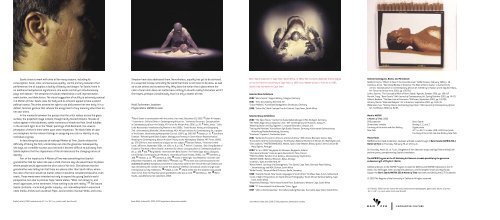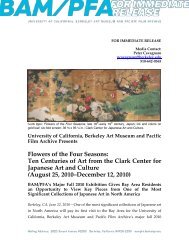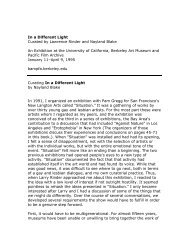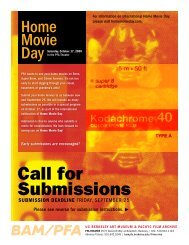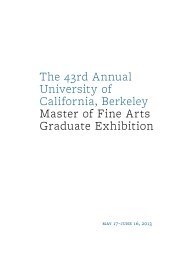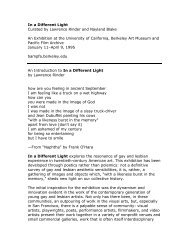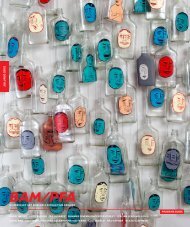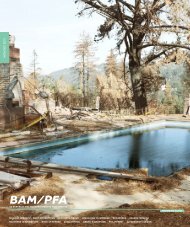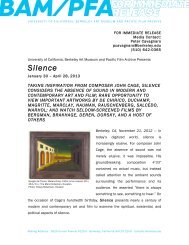Berni Searle - Berkeley Art Museum and Pacific Film Archive ...
Berni Searle - Berkeley Art Museum and Pacific Film Archive ...
Berni Searle - Berkeley Art Museum and Pacific Film Archive ...
Create successful ePaper yourself
Turn your PDF publications into a flip-book with our unique Google optimized e-Paper software.
<strong>Searle</strong> chose to work with olive oil for many reasons, including itsconsumption, flavor, color, <strong>and</strong> sensuous quality. As the primary material of herperformance, the oil supplies a duality of beauty <strong>and</strong> danger. For <strong>Searle</strong>, there isan additional metaphorical significance: she wants control yet simultaneouslyplays with taboos—the attraction/revulsion relationship in self-representation,exoticization, <strong>and</strong> didacticism. The visual suggestion of tactility is extremely sensualin A Matter of Time. <strong>Searle</strong> uses her body <strong>and</strong> its inherent appeal to take a potentpolitical stance. The artist asserts her right to use <strong>and</strong> present her own body. It is adefiant, feminist gesture that refuses the assignment of any meaning other than onher own terms.In the moments between the passes that the artist makes across the glasssurface, the projected image is black, though hardly monochromatic. Streaks ofcolors appear in the blackness, subtle variations of shade <strong>and</strong> hue. Small bubblesin the oil catch light. As in the “black” paintings of Ad Reinhardt, the viewer’sperception of what is there alters upon close inspection. The black fields of colorare metaphors for the inherent failings in assigning one color or identity to anyindividual or group.In describing the process of making A Matter of Time, <strong>Searle</strong> relates thedifficulty of taking the first, untried step out onto the glass box. Subsequently,she says, an incredible suction occurred <strong>and</strong> it became difficult to pull away from.<strong>Searle</strong> explains that the slipperiness of the oil references the changing nature ofidentity.Part of the impetus for A Matter of Time was something that <strong>Searle</strong>’sgr<strong>and</strong>mother told her when she was a child: that one day she would travel to placeswhere people would appreciate the olive color of her skin. She believes that hergr<strong>and</strong>mother was telling her that there are places other than South Africa, wherethe color of her skin would not matter, where it would be considered beautiful, evenexotic. These words were intended not only to exp<strong>and</strong> the young <strong>Searle</strong>’s worldperspective, but also to promise hope. <strong>Searle</strong> states, “What I am drawn to, <strong>and</strong>what I appreciate, is the sentiment. It has nothing to do with reality.” 19 The issues<strong>Searle</strong> confronts—racial <strong>and</strong> gender inequity—are now widespread in visual <strong>and</strong>news media. <strong>Art</strong>ists such as Adrian Piper, Janine Antoni, Hannah Wilke, <strong>and</strong> LornaSimpson have also addressed them. Nevertheless, equality has yet to be achieved.It is essential to keep reminding the world that there is still more to be done, as wellas to ask others <strong>and</strong> ourselves why. Why does the notion that a place where thecolor of one’s skin does not matter have nothing to do with reality? And when will it?One hopes, perhaps unrealistically, that it is only a matter of time.Heidi Zuckerman JacobsonPhyllis Wattis MATRIX Curator1 <strong>Berni</strong> <strong>Searle</strong> in conversation with the author, via e-mail, December 29, 2002. 2 Salah M. Hassan,“: Self <strong>and</strong> Other in Contemporary African <strong>Art</strong>, “ Authentic/Ex-centric: Conceptualismin Contemporary African <strong>Art</strong> (Ithaca, NY: Forum for African <strong>Art</strong>s, 2001), p. 26. 3 Kellie Jones, “ Life’sLittle Necessities: Installations by Women in the 1990s,” Trade Routes: History <strong>and</strong> Geography.2nd. Johannesburg Biennale (Johannesburg: AICA: Africus Institute for Contemporary <strong>Art</strong>, a projectof the Greater Johannesburg Metropolitan Council, 1997), pp. 286-287. 4 Hassan, p. 31. 5 See OkwuiEnwezor, “Reframing the Black Subject: Ideology <strong>and</strong> Fantasy in South African Representation,”Reading the Contemporary: African <strong>Art</strong> from Theory to the Marketplace (Boston: MIT Press, 1999),pp. 376-399 for a more extensive analysis on this subject. 6 Barbara Pollack, “Feminism’s NewLook,” ARTnews, September 2001, vol. 100, no. 8, p. 136. 7 Annie E. Coombes, “Skin Deep/Bodies ofEvidence: The Work of <strong>Berni</strong> <strong>Searle</strong>,” Authentic/Ex-centric: Conceptualism in Contemporary African<strong>Art</strong>, p. 198. 8 Ibid. 9 Rory Bester, “Interview with <strong>Berni</strong> <strong>Searle</strong>,” The Field’s Edge: Africa, Diaspora,Lens (Tampa: Contemporary <strong>Art</strong> <strong>Museum</strong>, University of South Florida, 2002), n/p. 10 Coombes, p.188. 11 Hassan, p. 31. 12 Coombes, p. 188. 13 Susan S. Weininger, “Ana Mendieta,” Grove<strong>Art</strong>.com(Macmillan Publishers, Ltd. 1998-2002). 14 Bester, n/p. 15 The work was commissioned for theAuthentic/Ex-centric exhibition presented in conjunction with the 49 th Venice Biennale (2001) <strong>and</strong>was intended by the curators to counter the absence of African conceptual artists in large-scaleinternational survey exhibitions. 16 Pollack, p. 136. 17 <strong>Searle</strong> notes that this tradition was passeddown to her from her Mauritian great-gr<strong>and</strong>father, who was a cook. 18 Coombes, p. 197. 19 <strong>Berni</strong><strong>Searle</strong>, unpublished artist statement, 2002.<strong>Berni</strong> <strong>Searle</strong> was born in Cape Town, South Africa, in 1964. She received a Bachelor of <strong>Art</strong>s degreein Fine <strong>Art</strong> from the University of Cape Town in 1987 <strong>and</strong> a Master of <strong>Art</strong>s in Fine <strong>Art</strong> in 1995.<strong>Searle</strong> lives <strong>and</strong> works in Cape Town.Selected Solo Exhibitions2002 “<strong>Berni</strong> <strong>Searle</strong>,” Seippel Gallery, Cologne, Germany2001 “Still,” Axis Gallery, New York, NY“Colour Matters,” Kunsthalle Stadtgallerie, Osnabrück, Germany1999 “Colour Me,” Mark Coetzee Fine <strong>Art</strong> Cabinet, Cape Town, South AfricaSelected Group Exhibitions2002 “The Spice Route,” Institut für Ausl<strong>and</strong>sbeziehungen (IFA), Stuttgart, Germany“The Field’s Edge: Africa, Diaspora, Lens,” USF Contemporary <strong>Art</strong> <strong>Museum</strong>, Tampa, FL“Watching Ocean <strong>and</strong> Sky Together,” Liverpool Biennale, Liverpool, U.K.“Tracing the Rainbow,” Kunst:Raum Sylt-Quelle, Rantum, Germany; Kulturverein Zehntscheuer,Rottenburg/NeckarRottenburg, Germany“Fronteras,” Espacio C, Sant<strong>and</strong>er, Spain2001 “Authentic/Ex-centric: Africa In <strong>and</strong> Out of Africa,” 49th Venice Biennale, Venice, Italy“Encounters with the Contemporary,” Smithsonian National <strong>Museum</strong> of African <strong>Art</strong>, Washington, D.C.“Dis-Locations,” PHOTOESPANA2001, Madrid, Spain; Sala Rekalde, Bilbao, Spain; Centro Cultural DeMaia, Oporto, Portugal2000 “A.r.e.a. 2000,” Reykjavik <strong>Art</strong> <strong>Museum</strong>, Reykjavik, Icel<strong>and</strong>“L’<strong>Art</strong> dans le Monde,” Culée du pont Alex<strong>and</strong>re III, Paris, France“FNB Vita 2000,” S<strong>and</strong>ton Civic Gallery, Johannesburg, South Africa“DAK’ART 2000,” National <strong>Museum</strong>, Dakar, Senegal“Insertion,” Apex <strong>Art</strong>, New York, NY“Kwere Kwere: Journeys into Strangeness,” The Castle, Cape Town; Gertrude Posel Gallery,Johannesburg; <strong>and</strong> NSA, Durban, South Africa“Afrika Porträt,” House of World Cultures, Berlin, Germany1999 “Towards-Transit: New Visual Languages in South Africa,” De Blaue Saal, Zurich, Switzerl<strong>and</strong>“Lines of Sight: Perspectives on South African Photography,” South African National Gallery, CapeTown, South Africa“Bloodlines/Bloedlyn,” Klein Karoo Kunste Fees, Oudtshoorn, Western Cape, South Africa1998 “7 th International Cairo Biennale,” Cairo, Egypt1997 “Life’s Little Necessities,” 2nd Johannesburg Biennale, The Castle, Cape Town, South AfricaSelected Catalogues, Books, <strong>and</strong> PeriodicalsBedford, Emma. “What’s It Mean? The Cairo Biennale.” Co@<strong>Art</strong>snews, February 1999, p. 19.Coombes, Annie. “Skin Deep/Bodies of Evidence: The Work of <strong>Berni</strong> <strong>Searle</strong>,” in Authentic/Excentric:Conceptualism in Comtemporary African <strong>Art</strong>, Edited by S. Hassan <strong>and</strong> O. Oguibe. Ithaca,NY: Forum for African <strong>Art</strong>s, 2001, pp. 178-201.Lewis, Desiree. “The Conceptual Work of <strong>Berni</strong> <strong>Searle</strong>.” Agenda, October 2001, pp. 108-117.Murinik, Tracy. ”<strong>Berni</strong> <strong>Searle</strong>.” NKA Journal of Contemporary <strong>Art</strong>, Spring/Summer 2001, pp. 74-79.Pollock, Barbara. “The New Look of Feminism.” ARTnews, September 2001, pp. 132-136.Vetrocq, Marcia. “Biennale Babylon.” <strong>Art</strong> in America, September 2001, pp. 104-115.Williamson, Sue. “Staking Claims: Confronting Cape Town.” NKA Journal of Contemporary African<strong>Art</strong>, Fall/Winter 2000, pp. 92-95.Work in MATRIXA Matter of Time, 2003DVD projectionDimensions variableCourtesy of the artist <strong>and</strong> Axis Gallery,New YorkPlease Note:MATRIX Curator Heidi Zuckerman Jacobson will lead a walkthrough of <strong>Berni</strong> <strong>Searle</strong>/MATRIX 202 AMatter of Time on Thursday, February 20, at 12:15 p.m.On Thursday, March 13, at 7 p.m., Daughters of Yam (devorah major <strong>and</strong> Opal Palmer Adisa) willperform poetry complementing <strong>Searle</strong>’s installation.The MATRIX Program at the UC <strong>Berkeley</strong> <strong>Art</strong> <strong>Museum</strong> is made possible by the generousendowment gift of Phyllis C. Wattis.Additional donors to the MATRIX Program include the UAM Council MATRIX Endowment, Ann M.Hatch, Eric McDougall, Glenn <strong>and</strong> April Bucksbaum, <strong>and</strong> Christopher Vroom <strong>and</strong> Illya Szilak.Support for <strong>Berni</strong> <strong>Searle</strong>/MATRIX 202 A Matter of Time has been provided by the LEF Foundation.© 2003 The Regents of the University of California. All rights reserved.<strong>Berni</strong> <strong>Searle</strong>Resting 1, 2, <strong>and</strong> 3Digital prints47 1 /4 x 40 1 /2 inches (120 x 102.8 cm) eachCourtesy of the artist <strong>and</strong> Axis Gallery, New YorkGirl (detail), 1999, from the ‘Colour Me’ series; blockmounted photographs, glass tubes, spices; 12 prints,16 1 /2 x 19 3 /4 in. each; photo credit Jean BrunditProfile (detail), 2002; lambda prints; 47 1 /4 x 38 2 /3 in.; photo credit Jean BrunditSnow White (video still), 2001; 2 DVD projections; dimensions variableSnow White (video still), 2001; 2 DVD projections; dimensions variableE N C O U N T E R C U LT U R E


